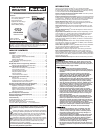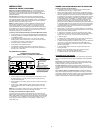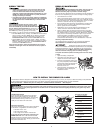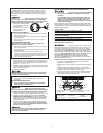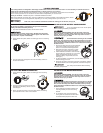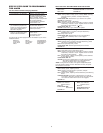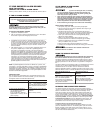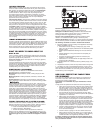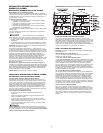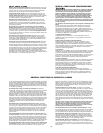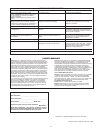
7
AFTER AN ALARM
After the emergency responders arrive, the premises aired out, and
your CO Alarm remains in its normal condition, you can check what
the highest carbon monoxide level sensed was:
Action:
1. Press & Hold Test Button
Alarm Will Say:
“Highest carbon monoxide level
was ___ ppm. Please see manual.”
“T
o clear highest carbon monoxide
level, press and hold test button
now.”
2. Press & Hold Test Button, if
you would like to clear the
highest level sensed.
If you would like to keep the
highest level in memory, do not
pr
ess anything.
“Highest carbon monoxide level
cleared.”
Alarm will say nothing.
I
F THE SMOKE ALARM SOUNDS
R
ESPONDING TO AN ALARM
• If the unit alarms and you are not testing the unit, it is warning
y
ou of a potentially dangerous situation that requires your
i
mmediate attention. NEVER ignore any alarm. Ignoring the
alarm may result in injury or death.
•
Never remove the batteries from a battery operated Smoke/CO
A
larm to stop an unwanted alarm (caused by cooking smoke, etc.).
Removing batteries disables the alarm so it cannot sense smoke,
a
nd removes your protection. Instead open a window or fan the
s
moke away from the unit. The alarm will reset automatically.
• If the unit alarms get everyone out of the house immediately.
W
HAT TO DO IN CASE OF FIRE
•
Don’t panic; stay calm. Follow your family escape plan.
•
Get out of the house as quickly as possible. Don’t stop to get
d
ressed or collect anything.
• Feel doors with the back of your hand before opening them.
I
f a door is cool, open it slowly. Don’t open a hot door. Keep doors
and windows closed, unless you must escape through them.
•
Cover your nose and mouth with a cloth (preferably damp).
Take short, shallow breaths.
•
Meet at your planned meeting place outside your home,
and do a head count to make sure everybody got out safely.
•
C
all the Fire Department as soon as possible from outside.
Give your address, then your name.
•
Never go back inside a burning building for any reason.
• Contact your Fire Department for ideas on making your home safer.
A
larms have various limitations. See "General Limitations of
S
moke/CO Alarms" for details.
USING THE SILENCE FEATURES
Never remove the batteries to quiet an unwanted alarm. Removing
the batteries disables the alarm and removes your protection.
The Silence Feature is intended to temporarily silence the horn while
you identify and correct the problem. Do not use the Silence Feature in
emergency situations. It will not correct a CO problem or extinguish a
fire.
The Silence Feature can temporarily quiet an unwanted alarm for several
minutes. You can silence this Smoke/CO Alarm by pressing the
Test/Silence button on the alarm cover for at least 3-5 seconds.
After the Test/Silence button is released, the Alarm Voice will say “Horn
silenced, detector active.” The Red LED blinks during the silence mode.
SILENCING THE LOW BA
TTER
Y W
ARNING
This Silence Feature can temporarily quiet the low battery warning
“chirp” for up to 8 hours if AC power is present. Press the Test/Silence
button on the Alarm cover until you hear the acknowledge “chirp”.
Once the low battery warning “chirp” silence feature is activated, the
unit continues to flash the green light once a minute for 8 hours. After
8 hours, the low battery “chirp” will resume. The Alarm will continue to
operate as long as AC power is supplied. However
,
r
eplace the batteries
as soon as possible,
to maintain protection in event of a power outage.
To deactivate this feature: Press the Test/Silence button again. The
unit will go into Test Mode and the low battery warning will resume
(LED flashes and unit sounds “chirp” once a minute).
To silence Alarms in an interconnected series:
To silence an interconnected series of Smoke/CO Alarms, you must
press the Test/Silence button on the initiating alarm (The unit with the
flashing red light; the red light will be off on all other Alarms.). If you
pr
ess the Test/Silence on any other Alarm, it will only silence that unit,
not the whole interconnected series.
When the Smoke Alarm is
Silenced
When the CO Alarm is
Silenced
The Smoke Alarm will remain
silent for up to 15 minutes, then
return to normal operation.
If the smoke has not cleared–or
continues to increase–the device
will go back into alarm.
The CO alarm will remain silent
for up to 4 minutes.
After 4 minutes, if CO levels
remain potentially dangerous the
horn will start sounding again.
IF THE CO ALARM SOUNDS
A
ctuation of your CO Alarm indicates the presence of carbon
monoxide (CO) which can kill you. In other words, when your CO
A
larm sounds, you must not ignore it!
I
F THE CO ALARM SIGNAL SOUNDS:
1. Operate the Test/Silence button.
2. Call your emergency services, fire department or 911. Write down
the number of your local emergency service here:
____________________________________________________________
3. Immediately move to fresh air—outdoors or by an open door or
window. Do a head count to check that all persons are accounted
f
or. Do not re-enter the premises, or move away from the open door
or window until the emergency services responder has arrived, the
p
remises have been aired out, and your CO Alarm remains in its
n
ormal condition.
4
. A
fter following steps 1-3, if your CO Alarm reactivates within a 24-
hour period, repeat steps 1-3 and call a qualified appliance
t
echnician to investigate for sources of CO from fuel-burning
e
quipment and appliances, and inspect for proper operation of this
equipment. If problems are identified during this inspection have the
e
quipment serviced immediately. Note any combustion equipment
n
ot inspected by the technician, and consult the manufacturers’
instructions, or contact the manufacturers directly, for more
information about CO safety and this equipment. Make sure that
motor vehicles are not, and have not, been operating in an attached
garage or adjacent to the residence. Write down the number of a
qualified appliance technician here:
____________________________________________________________
NOTE: A qualified appliance technician is defined as “a person, firm,
corporation, or company that either in person or through a representative,
is engaged in and responsible for the installation, testing, servicing, or
replacement of heating, ventilation, air conditioning (HVAC) equipment,
combustion appliances and equipment, and/or gas fireplaces or other
decorative combustion equipment.”
“
ALARM-MOVE TO FRESH AIR”
I
f you hear the CO alarm horn and the CO red light is flashing,
move everyone to a source of fresh air.
D
O NOT remove the batteries!
IF YOUR SMOKE/CO ALARM SOUNDS
WHAT TO DO FIRST–
IDENTIFY THE TYPE OF ALARM SIGNAL
R
efer to previous section "What you will see and hear with this alarm".



